Tomato nutrient needs
Tomatoes have consistent needs for nitrogen and potassium throughout their growth cycle. However, the ideal ratio between these two elements changes depending on the plant's stage of development. Supplying the correct ratio is crucial for proper growth and fruit development. For optimal fruit quality and to prevent the common problem of Blossom End Rot (BER), calcium is another essential nutrient in a tomato's nutritional program.
Nitrogen (N)
The form of nitrogen plays a significant role in tomato yield. It's recommended to use fertilizers with a high percentage of nitrate-nitrogen, such as potassium nitrate. Plants grown with ammonium-based fertilizers tend to have lower yields and experience more stress compared to those receiving only nitrate. Additionally, ammonium competes with calcium uptake, so using fertilizers low in ammonium helps prevent calcium deficiencies.
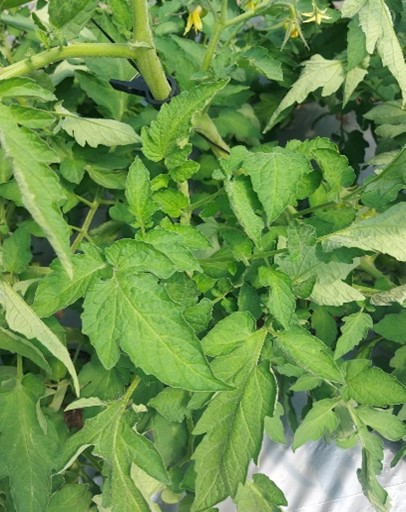
Nitrogen deficiency in tomato
Potassium (K)
Potassium is essential for optimal tomato growth and quality. Potassium nitrate is the recommended source because the nitrate form facilitates easy potassium uptake by the plant. Adequate potassium levels are crucial for various vital processes, including balancing electrical charges within the plant, regulating cell metabolism, and controlling osmotic pressure. These functions contribute to several benefits:
- Improved drought tolerance and reduced wilting
- Better disease resistance
- Promotion of vibrant red color development and reduced fruit color disorders
- Higher dry matter content in fruits
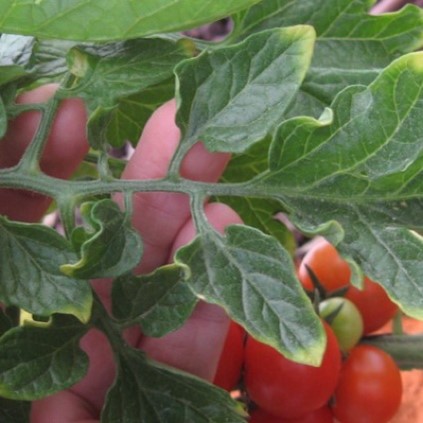
Potassium deficiency in tomato
Calcium (Ca)
Calcium plays a critical role in building strong cell walls, leading to firmer and better-shaped fruits. The calcium ion is immobile in the plant, which means that it moves from the roots to the upper organs only in the xylem.
Several factors can hinder calcium uptake and lead to Blossom End Rot (BER):
- Water stress
- Salt stress in the root zone
- High temperatures in dry conditions
- Limited root system
Careful calcium management is crucial under these conditions, including combined application of calcium fertilizers by Nutrigation™ (fertigation) and foliar sprays. It is also important to maintain an optimal Ca:Mg:K ratio of 3:1:3 to prevent competition between these elements and ensure sufficient calcium uptake.
Here are some additional strategies to enhance calcium uptake and prevent BER:
- Proper irrigation, especially when the weather is hot and dry.
- Night irrigations: calcium is absorbed by the plant during the day and transferred to the leaves. At night, when transpiration is low, calcium is transferred to the fruits.
- Select resistant varieties: some tomato varieties are more susceptible to blossom-end rot than others.

BER – a common disorder associated with calcium deficiency
Magnesium (Mg)
Magnesium is essential for healthy tomatoes, although only severe deficiencies will impact fruit size and yield. These deficiencies typically occur under low soil temperatures or inadequate irrigation, hindering magnesium uptake from the soil. If such conditions arise, applying magnesium foliar sprays with magnesium nitrate can prevent severe deficiencies.
While magnesium uptake competes with calcium and potassium, maintaining a balanced nutrient program prevents deficiencies and ensures optimal plant health.

Magnesium deficiency in tomato
Salinity
High salinity levels in the soil can hinder tomato plant growth. Soil electrical conductivity (EC) above 2.5 dS/m (saturated paste) can lead to decreased yields.
Under saline conditions, sodium competes with potassium uptake, and high chloride levels can also hinder the uptake of nitrate, both of which reduce plant development and fruit production. In such cases, corrective actions include applying ample potassium, nitrate-nitrogen, and calcium.
It should be noted that some tomato varieties, like cherry tomatoes, can tolerate higher salinity (EC above 4 dS/m). In these varieties, salinity can even improve sugar concentration and extend shelf life.
 | Establishment The developing root requires high levels of phosphorus (P). N-P2O5-K2O ratio of 1:1:1 is recommended at this stage. |
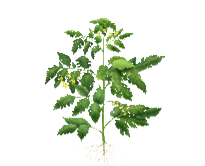 | Vegetative growth The recommended N-P2O5-K2O ratio at this stage is 1:1:1. |
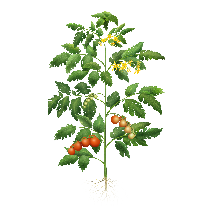 | From initial flowering till fruit-set When reproductive processes take place, the plant requires larger quantities of potassium while phosphorus requirements drop. The recommended N-P2O5-K2O ratio now is 2-1-3. |
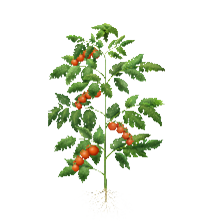 | Fruit development and maturation The growing fruits create a significant sink for potassium, and potassium absorption increases accordingly. To right N-P2O5-K2O balance at this stage shifts to f 5-3-10. |
See detailed fertilization recommendations.
Supplementary foliar nutrition
Foliar application of nutrients at specific stages of crop development boosts yields and improves quality. To boost vegetative growth, it is advised to supplement root nutrition with foliar application of fertilizers with N-P2O5-K2O ratio of 1:1:1.
At the reproductive stages, it is recommended to ensure adequate calcium levels by foliar application of readily available calcium preparations. This will help to prevent the development of BER.
Learn more about the benefits of foliar fertilizer applications.






